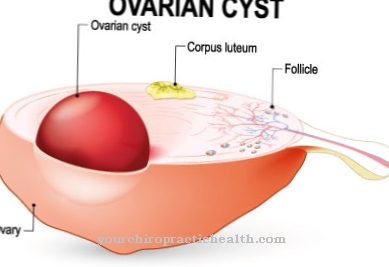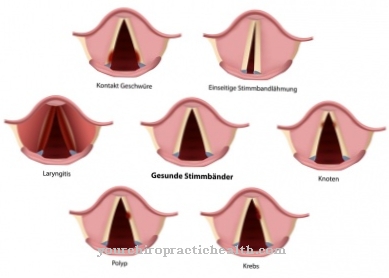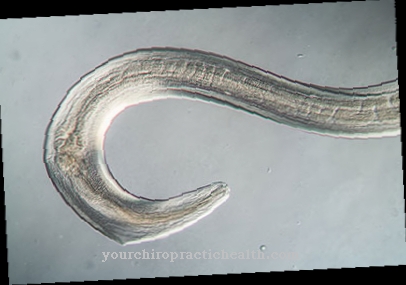The Blepharitis or Inflammation of the eyelid is a common eye disease. Itchy, burning and reddened eyes and adhesions on the edges of the eyelids, especially after waking up, are the typical complaints. There are several causes of blepharitis. An inflammation of the eyelid margin can also become chronic.
What is blepharitis?
.jpg)
In blepharitis or eyelid inflammation, the eyelid edges are inflamed. An inflammation of the eyelid margin can result from bacterial infections. But non-infectious reasons can also be responsible.
In some cases, blepharitis can recur and become chronic. Acute inflammations usually heal within a short time, provided they are treated properly. Untreated eyelid inflammation can damage the eyes. Medical treatment is therefore always advisable.
Typical symptoms are reddened, burning and itchy eyes. Especially after waking up, the edges of the eyelids can be stuck together. Depending on the cause of the disease, different therapies are used to treat blepharitis.
causes
Blepharitis can have different causes. In many cases it is caused by a bacterial infection. Staphylococci are the most common cause of infection. Staphylococci are found on most people's skin. They produce various substances that can cause inflammation in a weakened immune system.
Staph infection can often become chronic because the bacteria are constantly on the skin. In addition, an inflammation of the eyelid margin can be caused by infections, other bacteria or viruses. Pubic lice or mites also sometimes cause blepharitis.
Various dysfunction of the sebum glands and the skin disease rosacea are also causes of the disease in some cases. In addition, allergic reactions and external irritation factors such as drafts, heat, cold, dust, chemical substances, smoke and frequent eye rubbing are possible causes of blepharitis.
You can find your medication here
➔ Medicines for eye infectionsSymptoms, ailments & signs
Blepharitis typically involves burning and itching in the eyes. Usually the eyes are also very red and sticky. Especially in the morning after waking up, the edges of the eyelids are heavily encrusted and / or stuck together, and the eyes cannot be opened easily. Those affected also feel a foreign body sensation that increases as the inflammation progresses and causes severe discomfort.
An inflammation of the eyelid margin can lead to the development of scales on the edge of the eyelid or the lash line. In addition to the eyes, the eyelid rims are also red and moist, which gives them their typical shine. The discharge causes the eyelashes to stick together and appear oily and greasy as a result. Sometimes small oily droplets form in the area of the eyes, which can cause a strong stinging sensation if they get into the eye.
Blepharitis is sometimes associated with other symptoms such as fever or flu. Then symptoms such as tiredness, an increased pulse and discharge of secretions from the nose can occur. Outwardly, an inflammation of the Lind edge can be seen through the noticeable reddening and the adhesions. These signs can usually be used to clearly diagnose the condition.
Diagnosis & course
To diagnose blepharitis, the doctor first asks about any symptoms. Itchy, burning and reddened eyes and adhesions after waking up are usually clear indicators of an existing eyelid inflammation.
To confirm the diagnosis, the ophthalmologist looks at the eye with a slit lamp. A slit lamp throws a slit-shaped bundled light beam onto the eye and at the same time enables the doctor to view the eye in an enlarged form. If the typical symptoms of blepharitis occur, it is essential that an ophthalmologist be examined.
Complications
If left untreated, eyelid inflammation can damage the eye. This can lead to chronic conjunctivitis, scarred changes on the edge of the eyelid and loss of eyelashes. Acute blepharitis heals within a few days or weeks with treatment. Chronic eyelid inflammation cannot be cured. However, the symptoms of chronic blepharitis can be alleviated with appropriate treatment.
Blepharitis mainly results in complications and discomfort in the eyes. This can lead to itching or burning in the eyes.The quality of life is extremely reduced by the blepharitis and the symptoms mainly occur after sleep in the patient. If blepharitis is not treated by a doctor, it can cause severe damage and inflammation of the eye.
This can lead to conjunctivitis. The treatment itself can last several days or weeks and depends heavily on the severity of the inflammation. Treatment is primarily aimed at relieving symptoms. The affected person has to take antibiotics for a certain period of time and is dependent on eye drops or eye ointments.
There are no further complications or complaints and the course of the disease is positive. Blepharitis means that the patient is only slightly restricted in his everyday life. However, dusty and smoky areas must be avoided so that there are no further discomfort to the eye and the healing process is not prevented.
When should you go to the doctor?
Whether blepharitis needs medical treatment depends on its duration, extent and cause. It is important to differentiate between infectious and non-infectious eyelid inflammation.
If there are classic signs of inflammation (reddening, swelling, pain), it is in most cases an infectious blepharitis. It is often caused by bacterial pathogens, and more rarely viruses or parasites. The treatment must therefore be carried out by the ophthalmologist specifically for the pathogen. Self-treatment is not advisable because there is a risk of spreading pathogens to surrounding areas. In the worst case, this leads to an expansion of the local infection to the conjunctiva or cornea of the eye.
Non-infectious blepharitis, which is caused by a malfunction of the sebum glands in the eyelid (meibomian gland dysfunction, MDD), can initially be treated yourself if the symptoms are otherwise free. The recommended cleaning scheme (application of warm, moist compresses, eyelid massage and eyelid cleaning) should be used twice a day for a period of three to four weeks.
The use of a tear substitute can also aid healing. If the symptoms do not improve significantly after a few weeks or if additional complications occur, an ophthalmologist should be consulted.
Certain underlying diseases (rosacea, atopic dermatitis, seborrhoeic skin) promote the occurrence of eyelid inflammation. In the case of frequently recurring blepharitis, it is therefore advisable to have this clarified by a specialist in dermatology.
Doctors & therapists in your area
Treatment & Therapy
Blepharitis can be treated by a number of different measures. If bacterial infections are the cause, eye ointments containing antibiotics are used. In some cases, an antibiotic must be taken in the form of tablets. In almost all forms of blepharitis, eye ointments with anti-inflammatory agents are administered.
Sometimes an inflammation of the eyelid margin also disrupts the flow of tears. In these cases, the doctor will prescribe tear replacement fluid in the form of eye drops. If other diseases are the cause of blepharitis, they will be treated accordingly. In addition to all drug treatments, the eyelid should be cleaned daily to support the therapy.
In the process, incrustations should be carefully removed and the eyelid cleaned. Absolute hygiene should therefore be ensured so that any bacteria that may be present cannot spread further. Warm, damp compresses can help liquefy the hardened sebum in the glands of the eyelid. All supportive measures can alleviate the symptoms of blepharitis.
Outlook & forecast
The prognosis of blepharitis depends on the course of the disease. If the symptoms become chronic, there is a possibility that the patient will suffer from the inflammation for many years. A weakened immune system and old age of the person concerned are also unfavorable for a complete healing.
The outlook is good if the patient receives early treatment, is in middle adulthood and has no previous illnesses. With a healthy lifestyle and a balanced diet, the organism often has enough defenses to cure the inflammation on its own. With medical care for the eye, the healing process is significantly shortened.
Delays can occur if the patient develops an intolerance to the prescribed medication. Although there are a variety of alternative herbs, the physical reaction to the allergy can further weaken the immune system. This means that the organism has too few resources to successfully defend itself against the pathogens.
In severe cases, inflammation of the eyelid margin can lead to further germs penetrating the inside of the body. As a result, additional diseases develop, the prospects of which are uncertain. If the doctor's instructions are followed and the eyelid is also relieved through self-help measures, healing is possible within a few days or weeks.
You can find your medication here
➔ Medicines for eye infectionsprevention
There are no preventive measures against acute blepharitis. Acute eyelid inflammation can only be treated and the symptoms alleviated with appropriate treatment. If the eyelid margin inflammation is chronic, the eyelid should be hygienically cleaned every day. Stimuli that could trigger eyelid inflammation should also be avoided as far as possible. Drafts, smoke, or dust are among the factors that can cause blepharitis.
Aftercare
If acute blepharitis has healed and has been treated, medical follow-up care is not actually necessary. Temporary eye care is only recommended if the eyelids or eyes have been affected by infection and swelling. This can consist in the precautionary use of humectants or decongestant creams.
After blepharitis has been overcome, those affected should also refrain from unnecessarily irritating their eyes. From a hygienic point of view, regular washing of the face is sufficient. It is not necessary to manipulate the eyelids or eyes with your fingers unless it is related to the administration of medication.
Otherwise there are no noteworthy options for follow-up care, since acute blepharitis can usually be treated without complications. The chronic form of blepharitis can also be contained well with medication and eye hygiene.
It is therefore not necessary to take special measures once your own eyelids have become inflamed. Rather, incorrectly understood and excessive hygiene can also endanger the eye. Excessive hygiene measures often lead to dry eyes, injuries or irritation - all factors that favor the development of blepharitis.
However, people who frequently suffer from blepharitis should see their ophthalmologist more frequently.
You can do that yourself
To prevent eyelid inflammation, it is important not to expose the eyes to unnecessary irritation, e.g. B. Intense sun exposure without sunglasses, exposure to dust, irritation from dust or drying out from heating air in winter.
In the case of eyelid inflammation, it is very important to ensure adequate eyelid hygiene. This begins with moist, warm compresses in order to liquefy the thick secretion that clogs the lacrimal glands. To do this, you can moisten a fresh cloth or a fresh washcloth with warm water and place it on the eyes for about five to ten minutes. Please only use once and then put into the laundry. Then massage the edge of the eyelid with cleaned hands or a cotton swab towards the eyelashes to free the blocked glands from the secretion.
Careful cleaning of the eyelid margin is then important. It is best to get a cleaning solution from the pharmacy and use non-linting cotton swabs or pads. To avoid inflammation, all aids may only be used once and not for both eyes together. Dip the cotton wool in the cleaning solution and then carefully remove any incrustations or secretions from the outer eye.

.jpg)




.jpg)




















